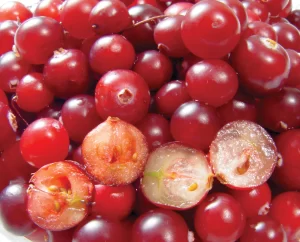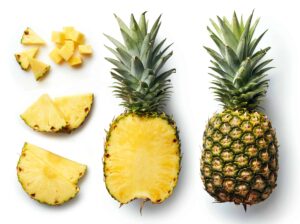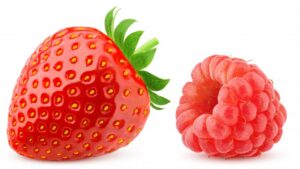Did you know that 80% of people believe pineapple is a tropical fruit?
Well, here’s a fascinating fact: pineapple is actually classified as a berry!
In this article, we will delve into the botanical classification of pineapple and explore its characteristics that make it a berry.
We will also compare pineapple to other berries and uncover the culinary uses of this versatile fruit.
Get ready to have your pineapple knowledge expanded and your taste buds tantalized!
Key Takeaways Is Pineapple a Berry
- Pineapples belong to the Bromeliaceae family and are tropical fruits widely cultivated.
- Pineapples have a tough, spiky outer skin called the rind and a juicy, fibrous flesh.
- Pineapples are classified as a multiple fruit or syncarp, as they develop from multiple flowers fusing together.
- Despite not meeting the technical definition of a berry, pineapple is scientifically classified as a fruit.
The Definition of a Berry
Do you know what makes a fruit a berry? Well, let us enlighten you.
According to botanical definitions, a berry is a fleshy fruit that develops from a single ovary, typically containing multiple seeds. It is important to note that not all fruits that we commonly refer to as berries actually meet this scientific criteria.

Take strawberries and raspberries, for example. Although we call them berries, they are actually aggregate fruits, formed from multiple smaller fruits that merge together.
On the other hand, fruits like grapes and tomatoes do meet the botanical definition of a berry.
Characteristics of Pineapples
The characteristics of pineapples include a sweet and tangy flavor, a spiky exterior, and a juicy flesh. Pineapples, scientifically known as Ananas comosus, belong to the Bromeliaceae family.

They are tropical fruits and are widely cultivated for their delicious taste and numerous health benefits. The sweet and tangy flavor of pineapples is due to the presence of citric acid, which gives them their characteristic taste.
The spiky exterior of pineapples, known as the rind, is made up of hexagonal-shaped scales that protect the juicy flesh inside. This juicy flesh is filled with vitamins, minerals, and enzymes, making pineapples a nutritious addition to any diet.
Additionally, pineapples contain an enzyme called bromelain, which has anti-inflammatory properties and aids in digestion. So, next time you bite into a pineapple, savor its unique flavor while reaping its many health benefits.
Types of Berries
When comparing strawberries and raspberries, it’s important to consider their key differences.
Strawberries are known for their bright red color and sweet taste. They have a higher water content and are larger in size compared to raspberries.

On the other hand, raspberries are slightly tart and come in a range of colors, including red, yellow, and black.
Moving on to unusual berry varieties, there are several lesser-known options to explore. Elderberries, goji berries, and cloudberries are just a few examples. Each of these berries has its own unique flavors and nutritional profiles.
Strawberry Vs Raspberry
Strawberries and raspberries are both delicious fruits that can be enjoyed in various desserts. While they belong to the same family, Rosaceae, they have distinct characteristics that set them apart.

Strawberries, scientifically known as Fragaria ananassa, are known for their bright red color, juicy texture, and sweet-tart flavor.
Raspberries, on the other hand, belong to the Rubus genus and are typically smaller with a deep red color and a slightly tangy taste.
Both berries are rich in antioxidants, vitamins, and fiber, making them a healthy addition to any diet.
Transitioning to the next section, there are also several unusual berry varieties that offer unique flavors and textures.
Unusual Berry Varieties
If you’re feeling adventurous, you should try some of the more unique berry varieties available. While strawberries and raspberries are the classics, there are other lesser-known options that can add excitement to your palette.
One such variety is the boysenberry, which is a cross between a blackberry, raspberry, and loganberry. It boasts a deliciously tart flavor and is perfect for making jams and pies.
Another interesting choice is the cloud berry, also known as the ‘bakeapple.’ This golden berry is found in the northern regions and has a sweet and tangy taste. It is highly sought after for its unique flavor and is often used in traditional Scandinavian desserts.
Lastly, if you’re up for a challenge, you can try the miracle fruit, a small red berry that alters your taste buds. After consuming it, sour foods taste sweet, providing a fascinating culinary experience.
Pineapple Anatomy
The outer layer of a pineapple, also known as the rind, is prickly and rough. This protective layer shields the inner flesh from harm, creating a unique and distinct fruit.
Let us delve into the anatomy of this tropical delight.
- The crown: At the top of the pineapple, there is a tuft of spiky leaves, resembling a crown.
- The core: Running through the center of the fruit is a fibrous core, which is not as sweet as the surrounding flesh.
- The flesh: The juicy, yellow flesh of the pineapple is packed with a tangy and sweet flavor.
- The eyes: Dotting the surface of the fruit are small, brownish ‘eyes’ that mark the location of the fruit’s flower spikes.
Understanding the structure of a pineapple allows us to appreciate its complexity and savor every succulent bite.
The Botanical Classification of Pineapple
When it comes to the pineapple, there is often confusion about its classification as a fruit or a berry. In order to better understand this, it is important to delve into the botanical classification of the pineapple.
Pineapple: Fruit or Berry
Pineapple is often considered a fruit rather than a berry. This distinction arises from the botanical definition of a berry, which requires a fruit to develop from a single ovary and contain multiple seeds. While a pineapple does develop from a single ovary, it only contains one seed, disqualifying it as a true berry. Instead, pineapple falls into the category of a multiple fruit, formed from the fusion of several individual flowers.
To paint a picture of this unique fruit, consider the following:
- Pineapple has a tough, spiky outer skin that ranges in color from green to golden yellow.
- Its juicy, fibrous flesh is yellow or white and is arranged in a spiral pattern.
- The flavor of pineapple is a delicious blend of sweetness and acidity.
- Pineapple contains an enzyme called bromelain, which gives it its characteristic tenderizing properties.
Understanding the botanical classification of pineapple helps us appreciate the complexity and diversity of the fruit kingdom. Now, let’s delve into the specifics of pineapple’s botanical classification.
Pineapple Botanical Classification
Pineapple is commonly considered a fruit due to its unique botanical characteristics. However, the question of whether pineapple is a fruit or a berry is still a topic of debate among botanists. To understand its botanical classification, let’s delve into its characteristics.
| Characteristic | Description | Classification |
|---|---|---|
| Shape | Oval or cylindrical | |
| Size | Can vary from small to large | |
| Skin | Rough, waxy, and spiky | |
| Flesh | Juicy and fibrous | |
| Seeds | Few to none |
Based on these characteristics, pineapple falls under the category of multiple fruits, also known as syncarps. A syncarp is formed when multiple flowers fuse together to create a single fruit. In the case of pineapple, the individual fruits fuse together, resulting in its unique shape and texture. So, while pineapple may not fit into the traditional definition of a berry, it is still scientifically classified as a fruit.
Pineapple: True Berry?
Moving on to the question of whether pineapple is a true berry, let us explore the scientific classification of this tropical fruit.
Despite its name, pineapple does not fit the technical definition of a berry. However, it is classified as a multiple fruit, which means it develops from the fusion of many individual flowers.
Here are some key characteristics of pineapple:
- Structure: Pineapple has a tough, spiky exterior and a sweet, juicy flesh inside.
- Reproduction: Pineapple reproduces through the dispersal of its seeds, which are found within the fruit.
- Growth: The plant grows from a basal rosette of leaves and produces a large, upright inflorescence that eventually develops into the fruit.
- Taxonomy: Pineapple belongs to the family Bromeliaceae and the genus Ananas, which includes several other species.
While pineapple may not be a true berry, it is still a delicious and nutritious fruit enjoyed by many around the world.
Pineapple Vs. Other Berries
Comparing pineapple to other berries, it’s interesting to note the differences in taste and texture.
While most berries have a sweet and juicy flavor, pineapple offers a unique combination of sweetness and acidity. Its distinct taste is due to the presence of bromelain, an enzyme that gives pineapple its tangy flavor.
In terms of texture, berries like strawberries and blueberries have a soft and delicate feel, whereas pineapple has a fibrous and slightly crunchy texture. This is because pineapple is made up of multiple fruitlets fused together, giving it a more robust structure.
Additionally, unlike most berries, pineapple is rich in vitamin C and manganese, making it a nutritious and delicious addition to any diet.
Culinary Uses of Pineapple
One popular way to incorporate this tropical fruit into your cooking is by using it as a topping for desserts like cakes or ice cream. Pineapple, with its sweet and tangy flavor, adds a refreshing twist to any dessert.
Here are four ways to use pineapple as a topping:
- Sprinkle diced pineapple over a creamy cheesecake for a tropical twist.
- Grill pineapple slices and place them on top of a warm brownie for a delicious contrast of flavors.
- Blend pineapple chunks into a smooth puree and drizzle it over a scoop of vanilla ice cream for a fruity burst.
- Create a pineapple salsa by combining diced pineapple, red onion, cilantro, and lime juice. Serve it over a slice of pound cake for a zesty and tropical dessert.
These pineapple toppings will elevate your desserts and bring a taste of the tropics to your table.
Fun Facts About Pineapples
Now that we have explored the culinary uses of pineapple, let’s dive into some fascinating facts about this tropical fruit.
Did you know that pineapples are not actually native to Hawaii, but were brought there from South America? They belong to the family Bromeliaceae, which includes other bromeliads like Spanish moss and air plants.
Pineapples are composed of many individual berries, or fruitlets, fused together around a central core. Each fruitlet contains a fibrous, juicy flesh that is rich in vitamins and enzymes.
Interestingly, pineapples are the only known source of an enzyme called bromelain, known for its anti-inflammatory properties.
In addition to being delicious and nutritious, pineapples also have a unique enzyme and a fascinating botanical history.
Frequently Asked Questions
Can Pineapples Be Considered a Fruit Other Than a Berry, According to Its Botanical Classification?
According to its botanical classification, pineapples are not considered a fruit other than a berry. While they have a different structure and composition, they still fall under the category of berries.
Are There Any Other Fruits That Share Similar Characteristics With Pineapples?
There are several other fruits that share similar characteristics with pineapples. They may have a similar shape, texture, or taste. Examples include dragon fruit, jackfruit, and guava.
What Are Some of the Unique Culinary Uses of Pineapples?
Some unique culinary uses of pineapples include using them in tropical fruit salads, grilling them for a sweet and tangy flavor, and incorporating them into savory dishes like pineapple salsa or Hawaiian-style pizza.
Can You Provide Some Fun Facts About Pineapples That Are Not Mentioned in the Article?
Sure! Pineapples are a tropical fruit known for their sweet taste and juicy texture. They are rich in vitamin C and bromelain, an enzyme with anti-inflammatory properties. Pineapples also have a unique spiky appearance and are a symbol of hospitality.
How Does the Anatomy of a Pineapple Differ From Other Fruits?
The anatomy of a pineapple sets it apart from other fruits. Its spiky skin protects its succulent flesh, arranged in a spiral pattern. The core holds the most concentrated flavor, while the sweetest juice lies in the outer layers.
Conclusion
In conclusion, pineapples are indeed berries.
As we have discussed, the botanical classification of a berry includes certain characteristics such as a fleshy pericarp and multiple seeds. Pineapples possess these attributes, making them a true member of the berry family.
Interestingly, despite its sweet and tangy taste, pineapple contains an enzyme called bromelain, which can break down proteins and has been used in traditional medicine for its anti-inflammatory properties.
So, the next time you enjoy a juicy slice of pineapple, remember that you are indulging in a scientifically classified berry with powerful health benefits.




